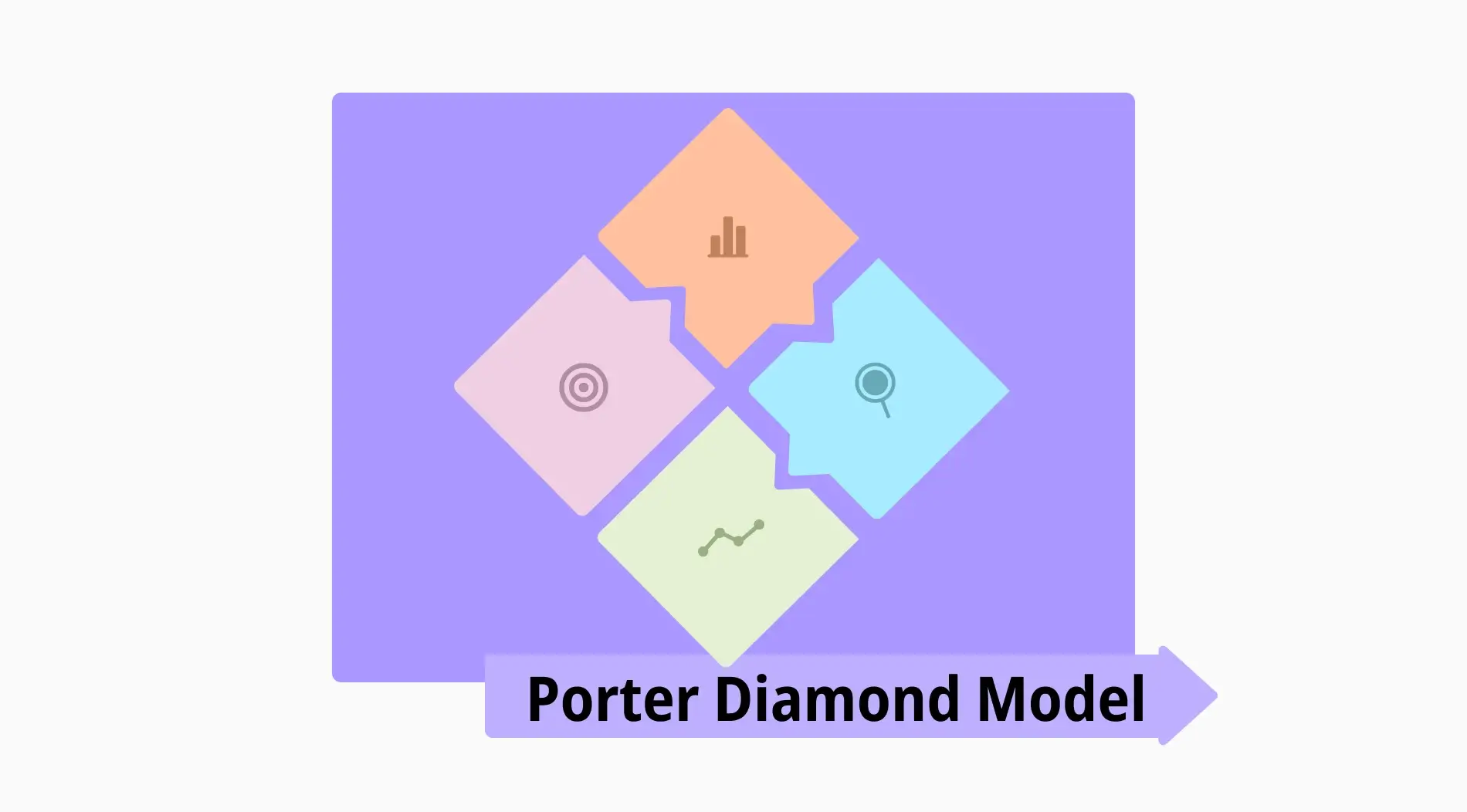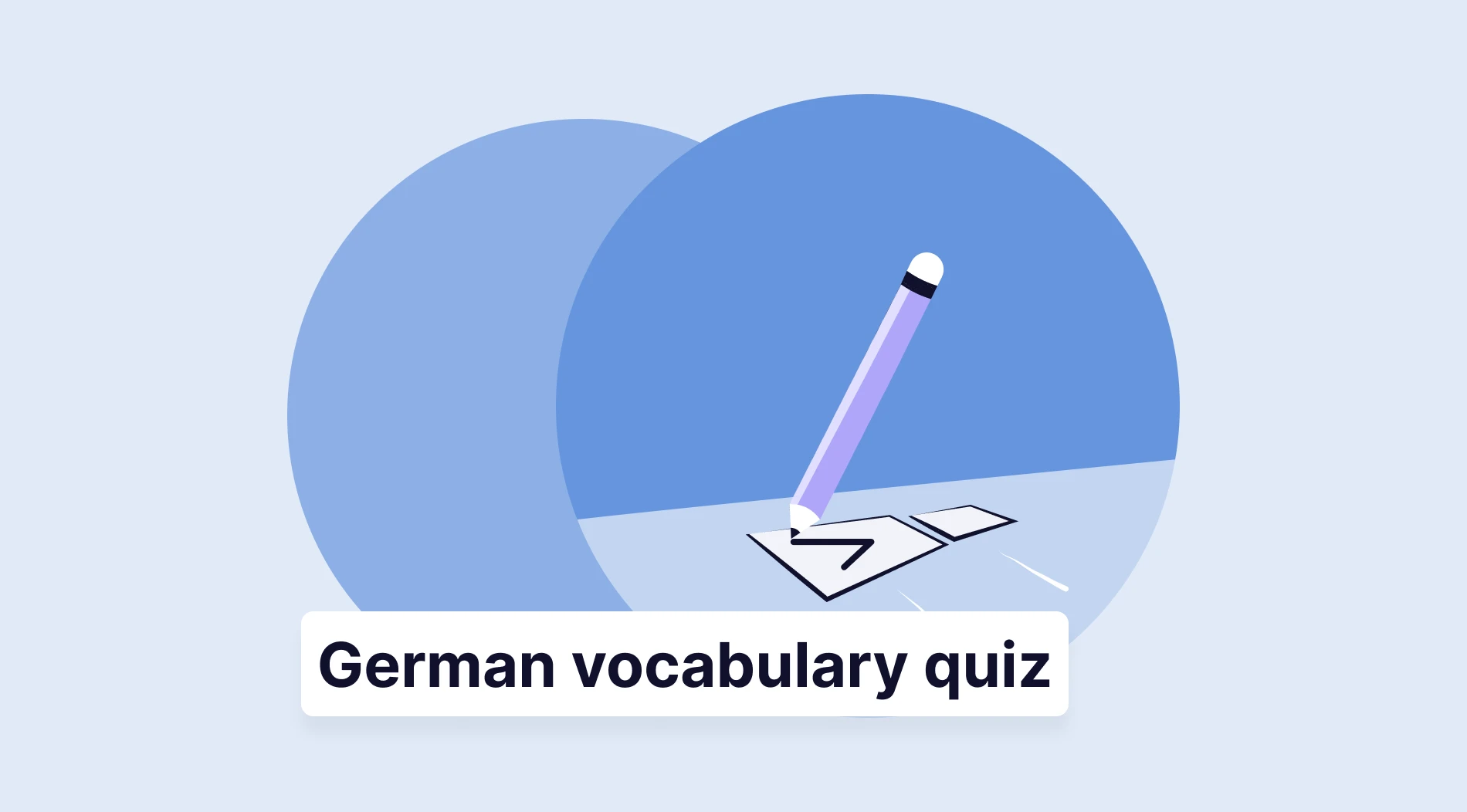In the modern business world, it is important to understand the strategic tools that help you unlock the competitive advantage of nations and industries. Whether you’re a business leader or an entrepreneur, mastering these business models can drive your success in the global market and enhance your business potential.
In this article, we'll explore the Porter Diamond Model in depth. You'll learn what it is, how it works, and how to use it to gain a competitive edge. We'll also examine real-life examples, their advantages and disadvantages, and when to apply them. Now, let’s delve into this practical model.
What is the Porter Diamond Model?
The Porter Diamond, developed by renowned economist Michael Porter, provides a framework for understanding the competitive advantage of nations and industries.
This model highlights the importance of the national context in shaping the competitive edge of industries within a country. Analyzing the interaction of various factors helps explain why certain industries in specific countries achieve international success.
This model comprises four main determinants that influence national competitive advantage: factor conditions, demand conditions, related and supporting industries, and firm strategy, structure, and rivalry. Additionally, government and chance events act as influencing factors. Understanding these components is crucial for businesses and policymakers aiming to enhance their competitive position on a global scale.
Porter Diamond Model: Explained
Now, let's explore Porter’s Theory of Competitive Advantage in detail. We'll explore its key components: factor conditions, demand conditions, related and supporting industries, and firm strategy, structure, and rivalry. Understanding these strategy elements will reveal how they interact to create a national competitive advantage.
Factor conditions
Factor conditions refer to a nation’s position in factors of production, such as skilled labor, infrastructure, and raw materials. These factors are essential for industries to compete effectively. For instance, a country with a highly skilled workforce and advanced technological infrastructure will have a significant advantage in high-tech industries.
Demand conditions
Demand conditions in the home market significantly influence how firms perceive and respond to customer needs. When the local market demands high-quality and innovative products and services, companies can meet these standards, fostering a competitive edge. This domestic pressure helps firms anticipate global market trends and preferences. The nature of home demand can push companies to innovate and stay ahead of international competitors.
Related and supporting industries
Strong related and supporting industries provide a competitive edge through synergies and innovation. When suppliers and related industries are competitive, firms can benefit from cost-effective inputs, new technologies, and joint ventures. This ecosystem fosters a collaborative environment that drives industry growth and competitiveness. Close proximity to suppliers and related industries can enhance communication and speed up innovation processes.
Firm strategy, structure, and rivalry
The nature of domestic competition and how companies organize and manage it impacts their success. Intense local rivalry forces firms to innovate and improve. The strategies and structures firms adopt in response to this competition shape their ability to compete internationally (such as premium prices). Different management practices and organizational structures can hinder or enhance a firm’s international competitiveness.
Government and chance
While not primary determinants, government policies and random events significantly shape the competitive environment. Government actions can influence all four determinants through regulations, subsidies, education, and trade policies. For instance, policies that support research and development can enhance factor conditions. Chance events like technological breakthroughs or natural disasters can also alter competitive dynamics, creating opportunities or challenges.
Porter Diamond model template
Creating a Porter Diamond Model template involves mapping out the four primary determinants: factor conditions, demand conditions, related and supporting industries, and firm strategy, structure, and rivalry. Additionally, it is crucial to include government and chance as influencing factors.
This visual representation, just like Porter's value chain, helps analyze and understand the competitive landscape of a nation or industry. This allows for strategic planning and decision-making. By assessing each component, businesses and policymakers can identify strengths, weaknesses, and opportunities for enhancing competitive advantage.
How to use the Porter Diamond Model
Let's explore how to effectively use the Porter Diamond Model. We'll guide you through six detailed steps to analyze and leverage this strategic tool. Each step will help you understand and apply the model to enhance your competitive advantage.
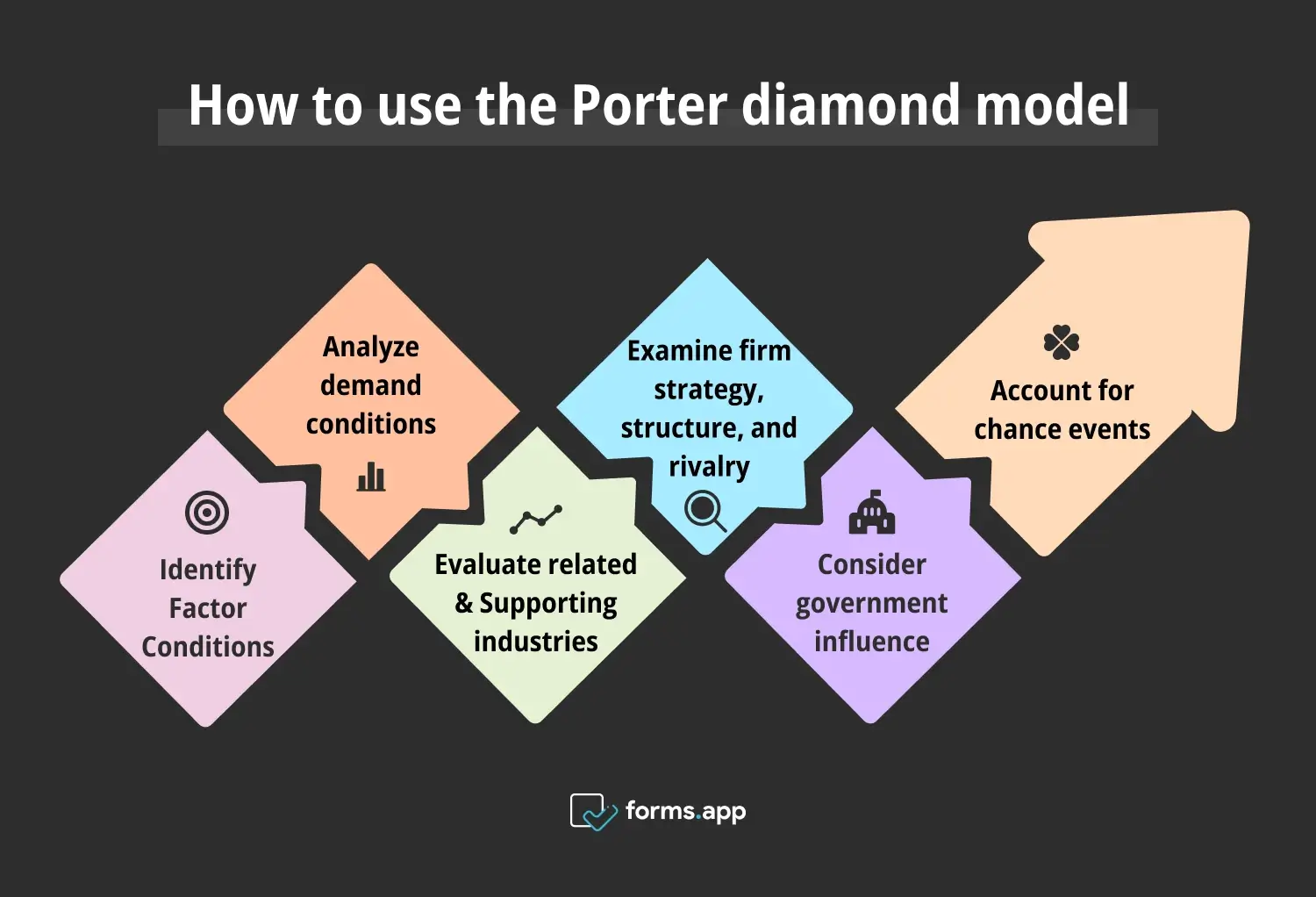
Steps to use the Porter Diamond Model
Step 1: Identify Factor Conditions
Begin by assessing the availability and quality of critical resources such as labor, infrastructure, and natural resources in the country. Evaluate how these factors contribute to the industry’s competitive advantage. For example, a country with advanced research facilities and a skilled workforce excels in high-tech industries. Understanding the depth of these factors can help in identifying areas for development and investment.
Step 2: Analyze demand conditions
Examine the characteristics of the domestic market demand. Determine if local consumers are sophisticated and demanding, pushing firms to innovate and maintain high standards. Industries with discerning local customers often perform better internationally due to their ability to meet high-quality standards. Analyzing consumer trends, preferences, and purchasing behavior can provide insights into potential future demands and innovations.
Step 3: Evaluate related & Supporting industries
Identify the presence and competitiveness of related and supporting industries. Strong suppliers and related industries can enhance innovation and efficiency. For instance, a robust automotive industry benefits from advanced steel and electronics sectors, leading to overall competitiveness. Investigate the level of collaboration and the nature of relationships between firms and their suppliers to understand how these interactions contribute to competitive advantage.
Step 4: Examine firm strategy, structure, and rivalry
Investigate how companies organize, their management practices, and the level of domestic competition. Intense local rivalry encourages continuous improvement and innovation. Firms in competitive domestic market segments are often better prepared to compete globally. Analyze the strategies employed by leading firms in the industry and how their organizational structures support or hinder their competitive efforts.
Step 5: Consider government influence
Analyze the role of government policies and regulations. Determine how government actions support or hinder the industry. Policies on education, trade, and infrastructure can significantly impact competitive advantage. For example, favorable trade policies can open up international markets.
Step 6: Account for chance events
Factor in the events that might influence the competitive landscape. These can include technological breakthroughs, natural disasters, or significant political changes. Understanding the potential impact of these events helps in strategic planning and risk management. Consider historical events and current trends to identify potential future disruptions or opportunities.
The Business Strategy: Diamond Framework Examples
Now, let's look at some strategy diamond model examples. We’ll see Michael Porter’s Diamond Model in action. We'll examine how various industries, such as Japan's automotive sector and Silicon Valley's tech hub, leverage this model to gain a competitive edge and drive innovation.
Japan’s automotive industry
Japan’s automotive industry thrives due to advanced factors like skilled labor and technological infrastructure. High domestic demand for quality vehicles pushes innovation. Strongly related industries, such as electronics, further bolster competitiveness. Intense rivalry among firms like Toyota and Honda drives continuous improvement.
Switzerland’s pharmacy sector
Switzerland excels in medicine due to its highly skilled workforce and advanced research facilities. Domestic demand for cutting-edge medical solutions spurs innovation. Collaboration with leading universities and research institutions strengthens the industry. Government support through favorable policies enhances competitive advantage.
Silicon Valley’s tech hub
Silicon Valley’s success stems from its skilled labor force, world-class universities, and innovative culture. High local demand for tech products drives continuous innovation. Proximity to leading suppliers and venture capital firms supports growth. Intense competition among tech giants fosters a dynamic and competitive environment.
Advantages and disadvantages of the Porter Diamond Model
Now, let's explore the advantages and disadvantages of the Porter Diamond Model. We'll discuss how this model provides comprehensive insights into national competitive advantage, as well as its limitations and challenges in application. Understanding these aspects will enhance its strategic use.
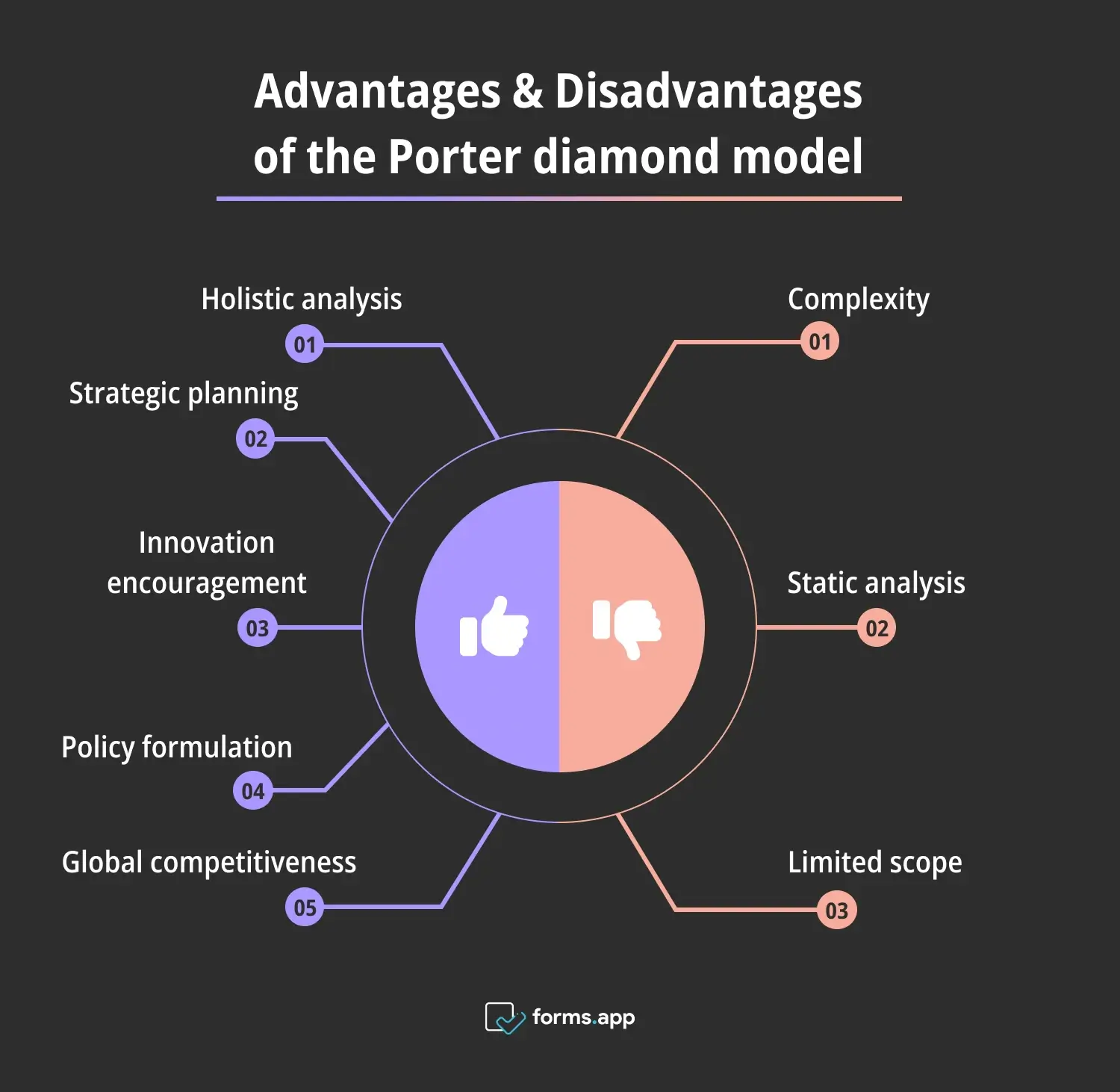
Pros and cons of the Porter Diamond Model
Advantages:
➕Holistic analysis: Provides a comprehensive framework for analyzing national competitive advantage by considering multiple determinants. This helps in understanding the broader context of industry success.
➕Strategic planning: Helps businesses and policymakers identify strengths and weaknesses. This makes strategic planning and decision-making easy. This enables targeted efforts to enhance competitiveness.
➕Innovation encouragement: Emphasizes the importance of innovation and continuous improvement driven by local competition. This fosters a culture of innovation within industries.
➕Policy formulation: Assists governments in developing policies that enhance national competitiveness by targeting specific determinants. This can lead to more effective economic and industrial policies.
➕Global competitiveness: Prepares firms to compete internationally by understanding and leveraging domestic advantages. This helps in identifying and leveraging on unique strengths.
Disadvantages:
➖Complexity: The model’s comprehensive nature can make it complex and challenging to apply, requiring detailed analysis and data. This may necessitate significant resources and expertise.
➖Static analysis: It may not fully account for dynamic changes in the global market and rapid technological advancements. This can limit it in fast-evolving industries.
➖Limited scope: Primarily focuses on national competitive advantage, potentially overlooking regional or industry-specific factors. This may not capture all nuances of competitive environments.
When to use the Porter Diamond Model
Much like Porter’s five forces, this model is also beneficial in certain environments. These can be industry analysis, market entry strategy, policy development, and strategic planning. Knowing when to apply this model maximizes its effectiveness.
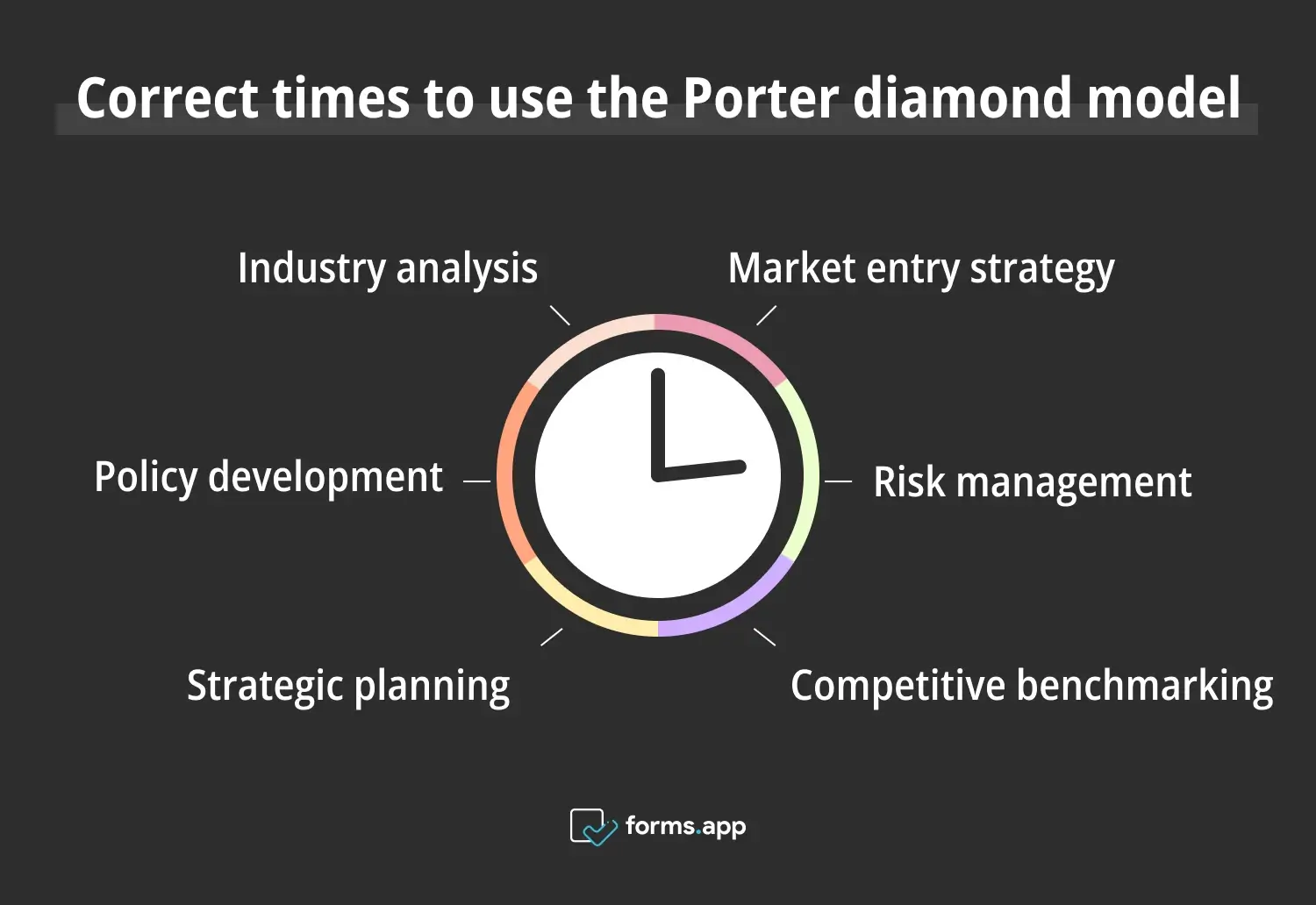
Right times to use the Porter diamond model
⏰Industry analysis: Use the model to analyze the competitiveness of specific industries within a country. This helps in identifying strengths and areas for improvement guiding strategic decisions and investments. It provides a detailed understanding of the factors driving industry success.
⏰Market entry strategy: Apply the model when planning to enter a new international market. It provides insights into the competitive landscape, helping businesses understand the factors that will influence their success. This aids in developing strategies that align with the unique conditions of the target market.
⏰Policy development: Governments can use the model to develop policies that enhance national competitiveness. By targeting the four determinants, they can create a conducive environment for industry growth and innovation. This ensures that policies align with the needs and strengths of industries.
⏰Competitive benchmarking: Businesses can use the model to benchmark their performance against competitors. This helps identify geographic areas where they can leverage national advantages to improve their competitive position. It provides a basis for strategic improvements and investments.
⏰Strategic planning: Incorporate the model into strategic planning processes to align business strategies with national strengths. This ensures that companies capitalize on available resources and market conditions. It helps in setting realistic and achievable strategic goals.
⏰Risk management: Use the model to identify potential risks and uncertainties in the competitive landscape. By understanding the impact of government policies and chance events, businesses can develop robust risk management strategies. This enhances resilience and leverage in dynamic markets.
Frequently asked questions about the Porter Diamond Model
Let's address some frequently asked questions about the Porter Diamond Model. We'll provide clear and concise answers to help you better understand this strategic tool, its components, and its applications. These insights will enhance your knowledge and practical use of the model.
With the diamond model, Michael Porter suggested four factor conditions, demand conditions, related and supporting industries, and firm strategy, structure, and rivalry. These elements interact to determine the sustainable competitive advantage of nations and industries. Additionally, government policies and chance events influence these determinants, shaping the overall competitive environment.
Porter's strategy model, known as the Porter’s Five Forces, analyzes the competitive forces shaping an industry. It includes the threat of new entrants, bargaining power of suppliers, bargaining power of buyers, threat of substitute product categories or services, and industry rivalry. This model helps businesses understand industry structure and develop competitive strategies.
Porter's national competitive theory, in the Porter Diamond Model, explains why certain industries within a nation are more competitive internationally. It identifies four key determinants. These are factor conditions, demand conditions, related and supporting industries, and firm strategy, structure, and rivalry, along with government and chance, as influencing factors that shape national competitive advantage.
Donald Hambrick and James Fredrickson contributed to strategic management theory with their concept of "Strategy as Stretch and Leverage," which aligns with Porter's ideas. Their work emphasizes the importance of strategic fit and the alignment between a firm's internal capabilities and external opportunities.
Wrapping it up
The Porter Diamond Model offers valuable insights into national competitive advantage. By understanding its components, businesses and policymakers can make informed decisions to enhance competitiveness. This model serves as a comprehensive framework for analyzing and leveraging the unique strengths of nations and industries.
We've covered the Porter Diamond Model's key aspects, including its components, usage, examples, and advantages. Apply this model to your strategic planning and witness its impact on your business success. Utilize the insights gained to drive innovation, improve competitiveness, and achieve sustained growth in the global market.
Fatih is a content writer at forms.app and a translator specializing in many text domains, including medical, legal, and technical. He loves studying foreign languages. Fatih especially likes to create content about program management, organizational models, and planning tools.
- What is the Porter Diamond Model?
- Porter Diamond Model: Explained
- Porter Diamond model template
- How to use the Porter Diamond Model
- The Business Strategy: Diamond Framework Examples
- Advantages and disadvantages of the Porter Diamond Model
- When to use the Porter Diamond Model
- Frequently asked questions about the Porter Diamond Model
- Wrapping it up
